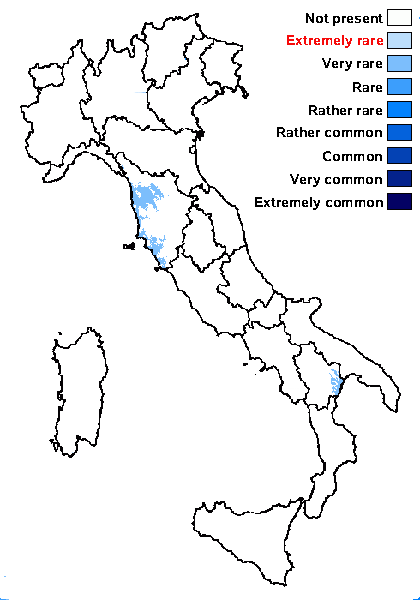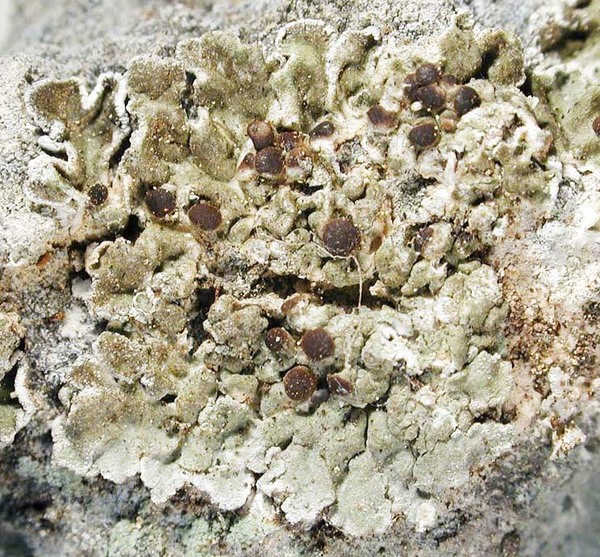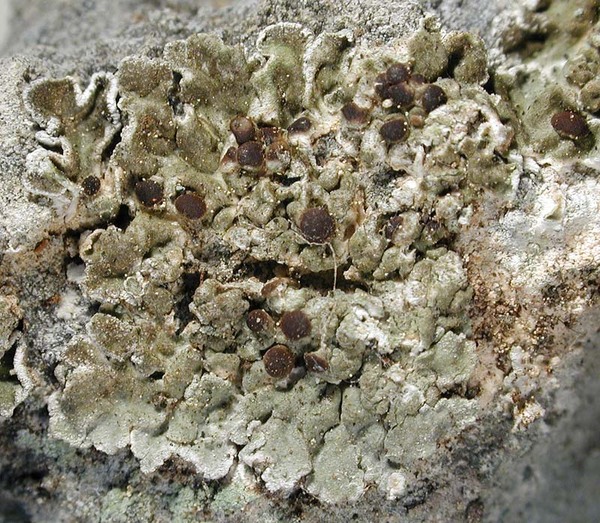Solenopsora marina (Zahlbr.) Zahlbr.
Cat. Lich. Univ., 5: 756, 1828. Basionym: Placolecania marina Zahlbr. - Österr. Bot. Z., 57: 396, 1907.
Synonyms:
Distribution: C - Tosc (Ravera & al. 2018b, 2023b, Isocrono & al. 2023). S - Bas (Potenza & al. 2014, Guttová & al. 2019).
Description: Thallus squamulose, pale green to glaucous green, up to 0.4 mm thick, forming rosettes or irregular, up to 5-6 cm wide patches. Outer squamules elongate, loosely attached by sparse rhizines, flexuose, folded, with white-pruinose margins; central parts of thallus crustose-areolate. Upper cortex paraplectenchymatous 40-50 µm thick; medulla white. Apothecia lecanorine when young, sessile, up to 0.5(-1) mm across, with a brownish, initially flat, finally strongly convex disc, and a thin, often white-pruinose, finally excluded thalline margin. Proper exciple of radially arranged hyphae; epithecium brownish; hymenium colourless, 60-90 µm high; paraphyses filiform, coherent, mostly simple; hypothecium colourless, 90-100 µm high. Asci 8-spored, cylindrical-clavate, with a K/I+ blue outer coat and a K/I+ uniformly blue apical dome, approaching the Catillaria-type. Ascospores 1-septate, hyaline, narrowly ellipsoid to fusiform, 9-16 x 3-3.5 µm. Pycnidia black, immersed. Conidia hyaline, simple, bacilliform, 3.5-4,5 x 0.5-1 µm. Photobiont chlorococcoid. Spot tests: cortex and medulla K- C-, KC-, P-. Chemistry: different terpenoids and unidentified substances.Note: on calcareous substrata, mostly in rock fissures and in humid and shaded situations; also known from the Dalmatian coasts and from the Ukraine.
Growth form: Squamulose
Substrata: rocks
Photobiont: green algae other than Trentepohlia
Reproductive strategy: mainly sexual
Most common in areas with a humid-warm climate (e.g. most of Tyrrenian Italy)
Taxon bound to maritime-coastal situations
Commonnes-rarity: (info)
Alpine belt: absent
Subalpine belt: absent
Oromediterranean belt: absent
Montane belt: absent
Submediterranean belt: absent
Padanian area: absent
Humid submediterranean belt: absent
Humid mediterranean belt: very rare
Dry mediterranean belt: very rare

Predictive model
Growth form: Squamulose
Substrata: rocks
Photobiont: green algae other than Trentepohlia
Reproductive strategy: mainly sexual
Most common in areas with a humid-warm climate (e.g. most of Tyrrenian Italy)
Taxon bound to maritime-coastal situations
Commonnes-rarity: (info)
Alpine belt: absent
Subalpine belt: absent
Oromediterranean belt: absent
Montane belt: absent
Submediterranean belt: absent
Padanian area: absent
Humid submediterranean belt: absent
Humid mediterranean belt: very rare
Dry mediterranean belt: very rare

Predictive model
 Index Fungorum
Index Fungorum
 GBIF
GBIF



